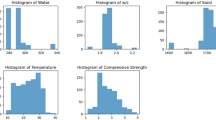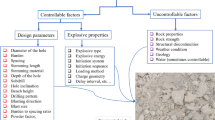Abstract
Blast block prediction is a complex non-stationary, nonlinear problem, the contribution of factors affecting results varies for different external conditions. Studies in a single environment are not universally applicable, the establishment of a blasted block size prediction model with fusion of multiple algorithms and reliable prediction results is the most urgent problem to be solved. In this study, a method is proposed that applies to different regions and rock conditions. To achieve the grouping prediction of blasted block size, this study firstly used hierarchical clustering to cluster the data in different areas, then used the random forest to establish the data grouping discriminant model based on the grouping results, and used back propagation neural network with genetic algorithm (GA-BP) to establish the blasted block size prediction model for each group of the blasted block size data separately. The results of the study show that (1) the block size data with different properties can be grouped according to the elastic modulus; (2) the grouping discriminant model established can correctly group the data; (3) compared with the GA-BP neural network prediction model without grouping, this model has a higher coefficient of determination (\({R}^{2}=0.982\) ) and smaller root mean square error (\(\mathrm{RMSE}=0.2\)) and mean relative error (\(\mathrm{MRE}=4.857\) ), which verifies the correctness of grouping prediction according to the elastic modulus; (4) by comparing with multiple regression, least squares support vector machines (LSSVM), and BP neural networks, the model outperforms the other models in \({R}^{2}\)\(\mathrm{RMSE}\), and \(\mathrm{MRE}\), and the prediction results are more accurate.










Similar content being viewed by others
References
Alireza K, Somaieh AZ (2012) Sizing of rock fragmentation modeling due to bench blasting using adaptive neuro-fuzzy inference system and radial basis function. Int J Min Sci Technol 22(004):459–463
Amiri M, Amnieh HB, Hasanipanah M, Khanli LM (2016) A new combination of artificial neural network and K-nearest neighbors models to predict blast-induced ground vibration and air-overpressure. Eng Comput 32:631–644. https://doi.org/10.1007/s00366-016-0442-5
Brown WK, Wohletz KH (1998) Derivation of the Weibull distribution based on physical principles and its connection to the Rosin-Rammler and lognormal distributions. J Appl Phys 78(4):2758–2763
Cunningham C (2005) The Kuz-Ram fragmentation model - 20 years on. Proc. 3rd EFEE World Conf. on Explosives and Blasting 201–210
Faramarzi F, Mansouri H, Farsangi M (2013) A rock engineering systems based model to predict rock fragmentation by blasting - ScienceDirect. Int J Rock Mech Min Sci 60(8):82–94
Gaudin AM, Meloy TP (1962) Model and a comminution distribution equation for single fracture. Trans Soc Min Eng od Aime 223(1):40–43
Gilvarry JJ (1962) Fracture of brittle solids. IV. Two-dimensional distribution function for fragment size in single fracture (theoretical). J Appl Phys 33(11):3214–3217
Gilvarry JJ, Bergstrom BH (1962) Fracture of brittle solids. III. Experimental results on the distribution of fragment size in single fracture. J Appl Phys 33(11):3211–3213. https://doi.org/10.1063/1.1931139
Grady DE (1990) Particle size statistics in dynamic fragmentation. J Appl Phys 68(12):6099–6105
Grady DE, Kipp ME (1995) Experimental measurement of dynamic failure and fragmentation properties of metals. Int J Solids Struct 32(17–18):2779–2781
Gui BB, Lin GH, Xie Y, Hui HU (2019) Fault diagnosis of wind turbine gearbox based on pso-bp. J Hunan Inst Eng (Natural Science Edition) 29(3):5
Guo D, Zhang Y, Xiao Z, Mao M, Liu J (2015) Common nature of learning between BP-type and Hopfield-type neural networks. Neurocomputing 167(nov.1):578–586
Hajihassani M, Armaghani DJ, Sohaei H, Mohamad ET, Marto A (2014) Prediction of airblastoverpressure induced by blasting using a hybrid artificial neural network and particle swarm optimization. Appl Acoustics 80:57–67. https://doi.org/10.1016/j.apacoust.2014.01.005
Harris C (1968) The application of size distribution equations to multi-event comminution processes. Trans AIME 241:343–358
Hasanipanah M, Amnieh HB, Arab H, Zamzam MS (2018) Feasibility of PSO-ANFIS model to estimate rock fragmentation produced by mine blasting. Neural Comput Appl pp. 30. https://doi.org/10.1007/s00521-016-2746-1
He J, Pan C, Liu Y, Du X (2019) Quantitative Analysis of Carbon with Laser-Induced Breakdown Spectroscopy (LIBS) Using Genetic Algorithm and Back Propagation Neural Network Models[J]. Applied Spectroscopy: Society for Appl Spectrosc 73(6):678–686. https://doi.org/10.1177/0003702819829555
Hudaverdi T, Kulatilake PHSW, Kuzu C (2011) Prediction of blast fragmentation using multivariate analysis procedures. Int J Numer Anal Meth Geomech 35(12):1318–1333
Ishwaran H, Malley JD (2014) Synthetic learning machines. Biodata Mining 7(1):1–12
Jackson WC, Norgard JD (2008) A hybrid genetic algorithm with boltzmann convergence properties. J Optim Theory App 136(3):431–443
Khandelwal M, Armaghani DJ (2016) Prediction of drillability of rocks with strength properties using a hybrid GA-ANN technique. Geotech Geol Eng 34(2)
King RP (2012) Modeling and Simulation of mineral processing systems
Koshelev ÉA, Kuznetsov VM, Sofronov ST, Chernikov AG (1971) Statistics of the fragments forming with the destruction of solids by explosion. J Appl Mech Tech Phys 12(2):244–256
Kulatilake P, Wu Q, Hudaverdi T, Kuzu C (2015) Mean particle size prediction in rock blast fragmentation using neural networks. Eng Geol 114(3–4):298–311
Li X, Xiang S, Zhu P, Wu M (2015) Establishing a dynamic self-adaptation learning algorithm of the BP neural network and its applications. International Journal of Bifurcation and Chaos 25(14):1540030
Lin L, Zhen J, Yang D (2019) Coarse-graining method based on hierarchical clustering on complex networks. Commun Network 11:21–34. https://doi.org/10.4236/cn.2019.111003
Meloy TP (1975) Material identification coding methods and systems: US, US3861886 A[P]. 1975-1-21
Esmaeili M, Salimi A, Drebenstedt C, Abbaszadeh M, AA Bazzazi (2015) Application of PCA, SVR, and ANFIS for modeling of rock fragmentation. Arab J Geosci 8:6881–6893. https://doi.org/10.1007/s12517-014-1677-3
Monjezi M, Bahrami A, Varjani AY (2010) Simultaneous prediction of fragmentation and flyrock in blasting operation using artificial neural networks. Int J Rock Mech Min Sci 47(3):476–480
Monjezi M, Dehghani H (2008) Evaluation of effect of blasting pattern parameters on back break using neural networks. Int J Rock Mech Min Sci 45(8):1446–1453
Ouchterlony F (2015) The Swebrec function: linking fragmentation by blasting and crushing. Min Technol 114(1):29–44
Ouchterlony F (2005) The Swebrec function : linking fragmentation by blasting and crushing. Taylor & Francis
Ouchterlony F, Sanchidrián JA (2019) A review of development of better prediction equations for blast fragmentation. J Rock Mech Geotech Eng 11(5):1094–1109
Persson PA (1994) Rock blasting and explosives engineering. Int J Rock Mech Min Sci Geomech Abstracts 6:278A
Rosin P, Rammler E (1933) The Laws governing the fineness of powdered coal. J Inst Fuel 7:29–36
Scornet E (2015) Random forests and kernel methods. IEEE Trans Inf Theory 62(3):1485–1500
Shi XZ, Zhou J, Bang-Biao WU, Huang D, Wei W (2012) Support vector machines approach to mean particle size of rock fragmentation due to bench blasting prediction. Transactions of Nonferrous Metals Society of China 22(2):432–441
Wang MS, Jiang XM, Long WF (1999) Predication of rockfill material size after blasting by revised KUZ-RAM mathematical model. Sichuan Water Power 18(4):77. https://doi.org/10.3969/j.issn.1001-2184.1999.04.026
Wang R, Wu S (2019). Neural network model based prediction of fragmentation of blasting using the Levenberg-Marquardt algorithm. J Hydrol Eng 38(7):100–109
Wang R, Zhu P (2020) Study on blasting fragmentation prediction model based on random forest regression method. J Hydroelectric Eng 39(1):89–101. https://doi.org/10.11660/slfdxb.20200110
Wang Y (2018) Research on key technologies of network performance optimization based on traffic monitoring. China Comp Commun 0(17):139–140
Wu R, Li B, Xia YuC, X, (2018) Model for blasting fragmentation prediction based on statistical classification. Chinese J Rock Mech Eng 037(001):141–147
Yin Y-J, Li R-Z, Chen M, Lu W-B, Yu Y-J, Shu W, Xia W-J (2019) Sensitivity analysis of influencing factors of blasting fragmentation distribution based on orthogonal experiment method. Blasting 036(004):37–42
Yoshida E (1997) Remark on the Kuznetsov trace formula. In Y. Motohashi (Ed.), Analytic number theory (London Mathematical Society Lecture Note Series, pp.377–382). Cambridge: Cambridge University Press. https://doi.org/10.1017/CBO9780511666179.026
Zhang YL, Zhou YJ (2019) Review of clustering algorithms. J Comp Appl 39(7):1869–1882. https://doi.org/10.11772/j.issn.1001-9081.2019010174
Zhou J, Shi X, Du K, Qiu X, Li X, Mitri HS (2016) Feasibility of random-forest approach for prediction of ground settlements induced by the construction of a shield-driven tunnel. Int J Geomech 17:04016129. https://doi.org/10.1061/(ASCE)GM.1943-5622.0000817
Zhou Xianping LI, Yanpo WUX, Yingguo HU (2018) New advance of control technique for blasting fragment-size of rock mass. Water Resour Hydropower Eng 49(S1):10–16
Xue JK, Shen B (2020) A novel swarm intelligence optimization approach: sparrow search algorithm. Syst Sci Control Eng 8:22–34. https://doi.org/10.1080/21642583.2019.1708830
Acknowledgements
Appreciate is expressed to Shijiao Yang, Qinpeng Guo, Zhibin Xiang. I would like to express my gratitude to all those who helped me during the writing of this thesis.
Funding
This study was financially supported by the National Natural Science Foundation of China (No.50974076), Postgraduate Scientific Research Innovation Project of Hunan Province (No. QL20210216), and Guangdong Xiyuan Blasting Technology Co., Ltd.
Author information
Authors and Affiliations
Contributions
All authors contributed to the study conception and design. Material preparation, data collection and analysis were performed by Yuchen Wang, Shijiao Yang, Qinpeng Guo and Zhibin Xiang. The first draft of the manuscript was written by Yuchen Wang and all authors commented on previous versions of the manuscript. All authors read and approved the final manuscript.
Corresponding authors
Ethics declarations
Competing Interests
The authors declare that they have no competing interests.
Additional information
Responsible Editor: Murat Karakus
Rights and permissions
Springer Nature or its licensor holds exclusive rights to this article under a publishing agreement with the author(s) or other rightsholder(s); author self-archiving of the accepted manuscript version of this article is solely governed by the terms of such publishing agreement and applicable law.
About this article
Cite this article
Wang, Y., Guo, Q., Yang, S. et al. A prediction model for blasted block size grouping based on HC and RF-GA-BP neural network. Arab J Geosci 15, 1391 (2022). https://doi.org/10.1007/s12517-022-10645-x
Received:
Accepted:
Published:
DOI: https://doi.org/10.1007/s12517-022-10645-x




